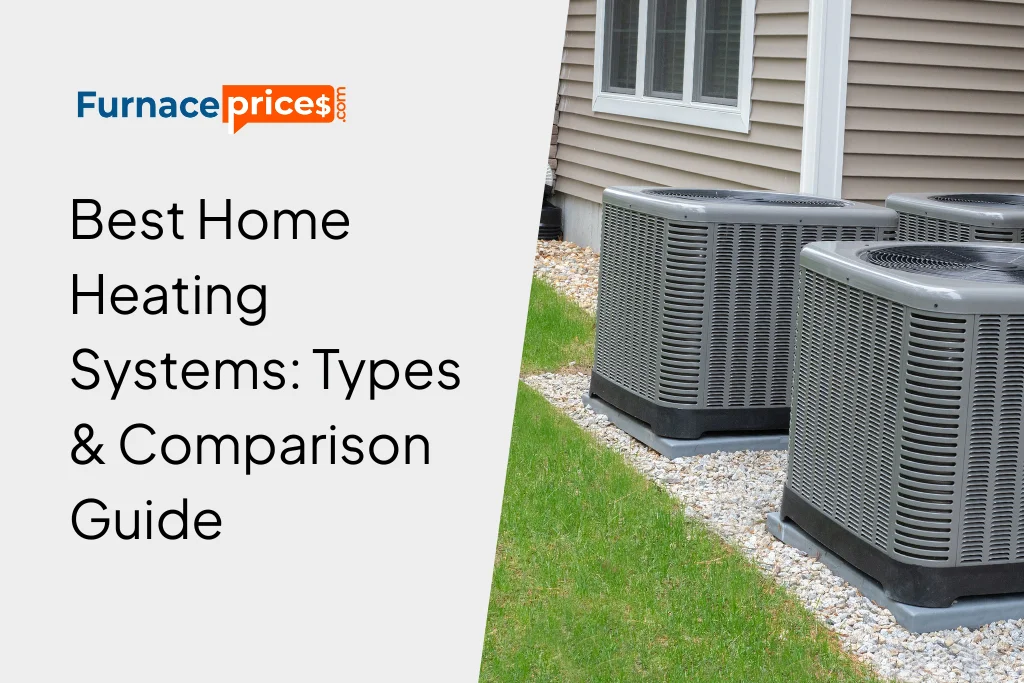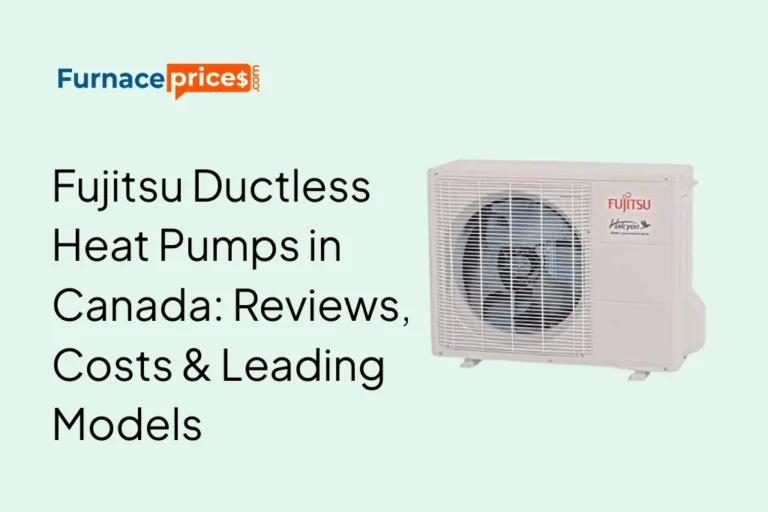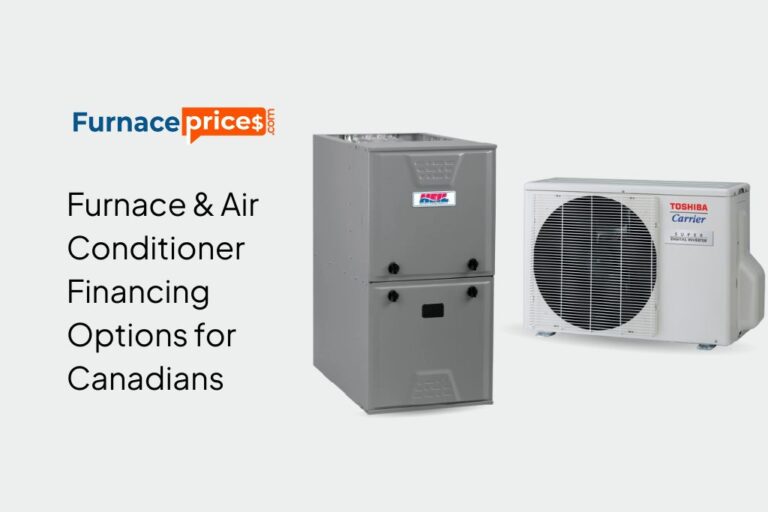Best Home Heating Systems: Types & Comparison Guide

Looking for the best home heating system for your Canadian home? There are several factors to consider, including installation costs, fuel expenses, reliability, and overall comfort. Homeowners also have numerous options ranging from traditional systems to modern, energy-efficient solutions. This guide compares various home heating system types to help you make an informed decision for your home in Canada.
Home Heating System Types
Choosing the right heating system begins with selecting the type of system that suits your home’s layout, size, and heating needs. The right size is crucial to ensure efficiency and comfort. Here’s an overview of the main heating systems suitable for Canadian homes, along with additional insights to help you evaluate their suitability for your property.
Central Heating Systems (Ducted System)
A central heating system uses ductwork throughout your home to distribute warm air. Several popular home heating systems fall into this category. Central heating is often preferred for larger homes because it provides consistent temperature control in multiple rooms. Choosing the right ducted system can also make it easier to integrate advanced thermostats and zoned heating, which improves comfort while reducing energy costs.
Furnaces
Furnaces are one of the most common heating systems in Canadian homes. They burn fuel to warm air that passes through a heat exchanger. Operating costs depend largely on the type of fuel used, and prices vary based on the system’s efficiency, size, and features.
Gas Furnace
Gas furnaces are among the most cost-effective heating options. They burn natural gas, which is relatively affordable, but this option is only viable if your home is connected to a natural gas network. Modern high-efficiency gas furnaces can achieve efficiency ratings above 95%, which reduces monthly energy bills significantly. Many models also include modulating burners or variable-speed blowers to improve comfort and efficiency further.
Oil Furnace
Oil furnaces require a fuel oil tank and regular deliveries. With rising fuel oil prices, this option can be less budget-friendly compared to other heating methods. However, oil furnaces provide high heat output and can be a reliable solution in areas where natural gas is unavailable. Annual maintenance and periodic cleaning of burners and heat exchangers are important to maintain performance and prevent costly repairs.
Electric Furnace
Electric furnaces use electricity instead of combustion to generate heat. They are suitable for replacing gas or oil furnaces where electricity is available, but other electric heating systems may provide better efficiency. Although they tend to have higher operating costs in regions with expensive electricity, they have the advantage of minimal emissions and simpler maintenance requirements.
Heat Pumps
Heat pumps are highly efficient because they transfer heat instead of generating it. They can warm your home in winter and provide cooling in summer. By moving heat using electricity, they often deliver lower energy costs than other electric heating options. Modern Canadian models are designed to operate effectively in cold climates, often down to -25°C.
Air Source Heat Pumps
These systems extract heat from outdoor air and transfer it indoors through your ductwork. Modern air source heat pumps can operate effectively even in colder Canadian winters, though extreme temperatures may affect performance. Some models include a supplemental electric heater to maintain consistent warmth during extreme cold snaps, ensuring comfort without a dramatic increase in energy use.
Ground Source (Geothermal) Heat Pumps
Ground source heat pumps work similarly but draw heat from the ground, which remains warmer in winter than outdoor air. This often makes them more reliable than air source pumps in extremely cold regions. The initial installation cost is higher due to the ground loop system, but energy savings over time can be substantial. Geothermal systems also have an extremely long lifespan, often exceeding 20 years, with minimal maintenance requirements.
Ductless Mini-Split Heating System
Ductless mini-splits are ideal for homes without ductwork. Instead of one central unit, several smaller units are installed in different rooms, giving homeowners individual control over each space. This system is efficient and flexible, especially in homes with unique layouts or additions. Mini-splits also allow for zoning, which means you only heat the rooms in use, lowering energy costs. Some models even offer advanced features like programmable schedules and smart home integration.
Direct Heating Systems
Direct heating systems warm the air immediately surrounding the unit instead of distributing heat through ducts. These systems are generally easier to install and ideal for smaller homes or rooms.
Electric Baseboard Heating
Baseboard heaters are installed along room walls and provide direct warmth. Installation is usually straightforward and cost-effective, but operating costs can be high in regions with expensive electricity. Baseboard systems are quiet, low-maintenance, and provide gradual, evenly distributed heat. They are also highly controllable with individual room thermostats, making them suitable for homes where heating needs vary between rooms.
Boiler Systems
Boilers heat water that circulates through radiators or in-floor piping, rather than using ducts. Boilers may operate using combustion fuels or electricity and can provide consistent, comfortable heat throughout your home. Hydronic systems, which use water as a heat transfer medium, offer excellent efficiency and even heat distribution. They are particularly effective for homes with multiple floors or larger square footage, as water retains heat longer than air, providing steady warmth throughout the home.
Fireplaces & Woodstoves
Fireplaces and woodstoves burn wood or pellets to produce heat. They are reliable and can work even during power outages, but they provide localized heat, so additional systems may be needed for whole-home comfort. Wood-burning options offer an eco-friendly alternative if sustainably sourced wood is used. Modern pellet stoves are also very efficient and can be programmed for automatic operation, making them more convenient than traditional fireplaces.
How to Choose the Best Home Heating System
Selecting the right heating system depends on multiple factors. Canadian homeowners should consider climate, home size, fuel availability, and more. Here’s a deeper look at these factors to guide your decision:
Climate & Location
Canada’s climate heavily influences heating system choice. Furnaces and boilers are powerful and effective in severe winters, while heat pumps may lose efficiency in extreme cold. Knowing your region’s average winter temperatures will help you make the best decision. In provinces like Ontario, Manitoba, and Saskatchewan, winter temperatures can fluctuate dramatically, so choosing a system that maintains consistent comfort without excessive energy costs is key.
Home Layout & Size
Smaller homes may only require a few ductless mini-splits or a woodstove for sufficient warmth. Larger homes usually benefit from a furnace or boiler to distribute heat evenly across multiple rooms and levels. Open-concept designs may require more powerful heating solutions to maintain consistent temperatures, while multi-level homes can benefit from zoned heating systems for better efficiency and comfort.
Fuel Availability & Cost
Not all fuel types are available everywhere. Natural gas is inexpensive but limited to areas with pipeline access. Firewood availability varies by region. Electricity is widely accessible, but prices fluctuate by province, affecting operating costs. When comparing heating systems, consider both the current fuel cost and projected future changes, as these will influence the total lifetime expense of your system.
Insulation Levels
Good insulation significantly impacts heating efficiency. Poorly insulated homes will lose heat rapidly, increasing energy bills regardless of system type. Upgrading insulation, sealing leaks around windows and doors, and adding high-quality weather stripping can greatly enhance heating efficiency. Well-insulated homes allow for smaller, more efficient systems and reduce energy waste.
Ductwork Availability
Existing ductwork makes installing a furnace or central heat pump straightforward. Adding new ducts can be expensive or impractical in some homes. Using existing ducts when possible is a smart way to manage installation costs. Homes without ducts may benefit more from ductless systems or boilers, which can often be installed with minimal structural changes.
Environmental Impact
Many homeowners now consider their heating system’s carbon footprint. Heat pumps are generally the most energy-efficient option, moving heat rather than generating it. However, electricity is not always carbon-free in Canada; some provinces rely on fossil fuels, while others use largely renewable sources. If sustainability is a priority, consider systems that can utilize renewable energy sources, such as geothermal heat pumps or pellet stoves.
Government Rebates & Incentives
Federal and provincial programs offer rebates to homeowners installing energy-efficient systems, particularly heat pumps. Grants may cover up to $5,000 depending on your current heating system and the type and size of the heat pump installed. Checking local programs can make upgrading more affordable. Some provinces also provide additional incentives for high-efficiency furnaces, boilers, or insulation improvements, which can further reduce installation costs.
Maintenance Requirements by Heating System
Regular maintenance ensures your heating system runs efficiently and safely. Here’s a breakdown of typical upkeep for different types:
- Electric Baseboards – Minimal maintenance; mostly cleaning.
- Boilers – Simple upkeep, though water leaks can be costly to repair.
- Furnaces – Require regular filter changes, inspections, and occasional part replacements.
- Heat Pumps – Need air filter maintenance and refrigerant system checks.
Annual tune-ups are recommended for all systems to maintain performance and safety. In addition, homeowners should monitor for unusual noises, uneven heating, or rising energy bills, which may indicate the system needs servicing.
Don’t Rush Your Decision
Heating accounts for roughly 29% of an average Canadian household’s utility bills. Choosing the right system requires careful consideration of climate, home size, fuel costs, and efficiency. Comparing options and obtaining multiple quotes ensures you find the best home heating system for your needs. Taking the time to evaluate system longevity, operating costs, and compatibility with your home’s design will help you make a decision that is both practical and cost-effective for years to come.
For more information on energy efficiency standards and incentives in Canada, visit Natural Resources Canada.
📞 Have questions? Contact us or email us at contact@furnaceprices.com.
✅ Start comparing today and make the right choice with confidence!







